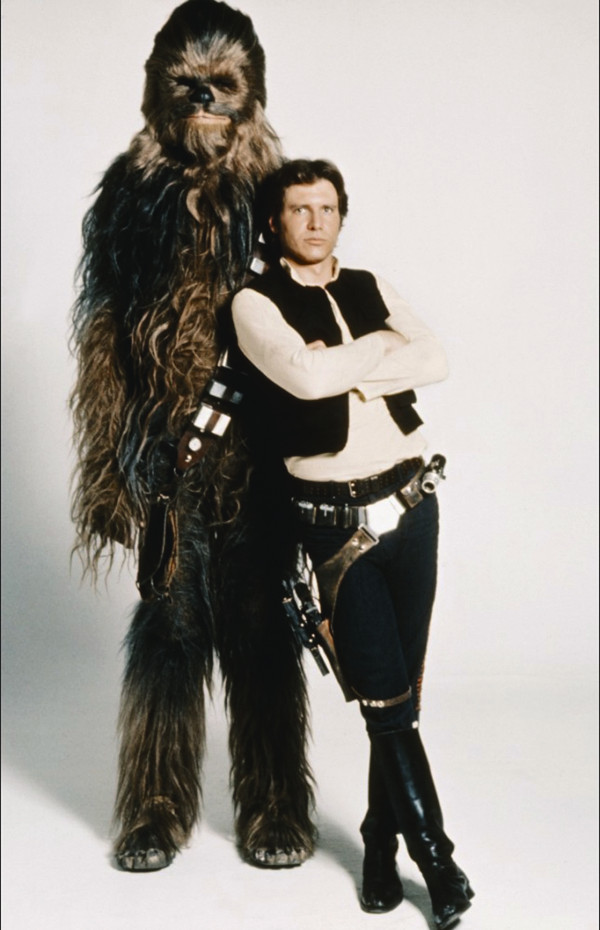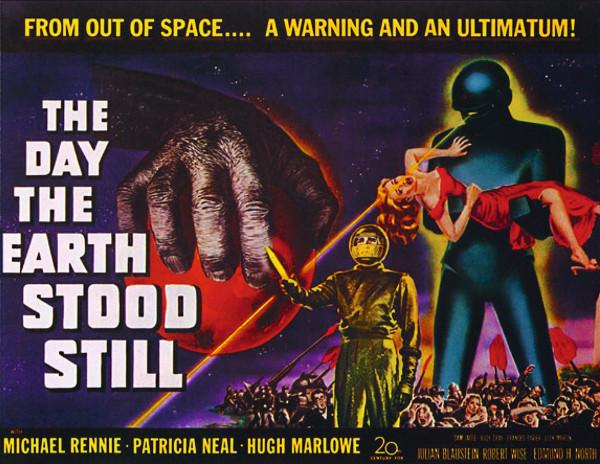The race to the moon and other planets has been depicted in movies and film for over 100 years now. Our species has a natural curiosity and desire to travel to other planets which will perhaps one day be our only hope for survival. Populating the universe seems to be implanted in our DNA for a specific reason. Aliens and space travel movies were especially popular during the Cold War era. Only a few years later Neil Armstrong set foot on the moon for the first time in 1969. An astronaut sent to inhospitable Mars will be our next great voyage. There are a plethora of space films out there. Below are some important classics and pivotal movies about space travel and the iconic costumes that made them great.
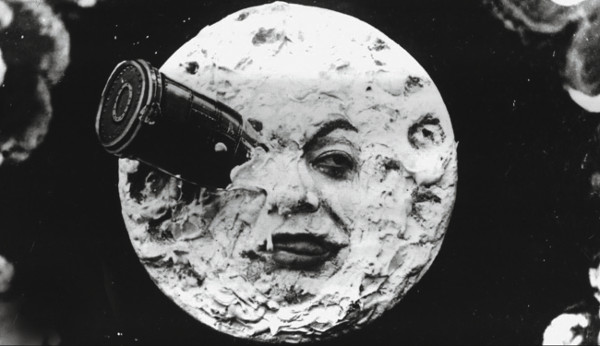
A Trip to the Moon (1902)
This film was a 14 minute silent film masterpiece created by imaginative French director and master magician Georges Méliès. Widely regarded as the first space travel film ever, it’s a lighthearted yet whimsical satire criticizing the conservative scientific community of its time. It was inspired by Jules Verne’s From the Earth to the Moon (1865) and the novel by H. G. Wells The First Men in the Moon(1901). Méliès was a one man band as he wrote the script, acted as the lead role, designed the sets/costumes, directed, photographed, and produced the film! He hired acrobats from the Folies Bergère to play the alien, ant-like Selenite characters. The famous scene of the lunar capsule landing in the eye of the moon has made its mark in cinematic history forever. Méliès later wrote about the Selenite costumes saying: “Their shells, heads, feet, everything was made specifically, and in consequence, expensive. I myself made the models done in clay; the plaster moulding and the costumes were made by a maker of special masks, used to working with papier-mâché…” A Trip to the Moon is truly one of the earliest movie masterpieces of all-time!
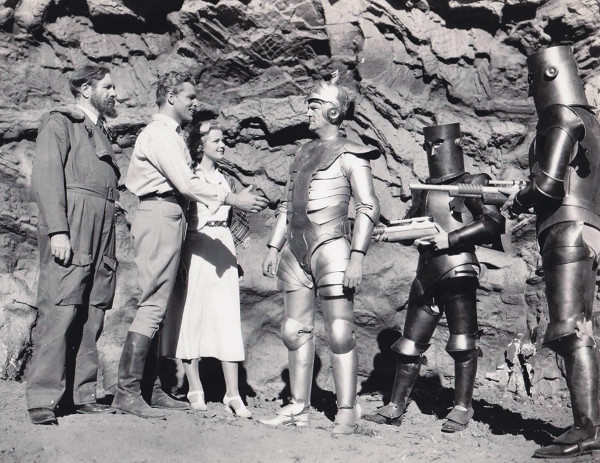
Flash Gordon (1936)
Many a kid grew up watching Flash Gordon which has since become a cult classic with fans of science fiction and fantasy. Flash Gordon was the hero of a space opera adventure comic strip originally drawn by artist Alex Raymond. The Flash Gordon comic strip has been translated into a wide variety of media, including motion pictures, television, and animated series.
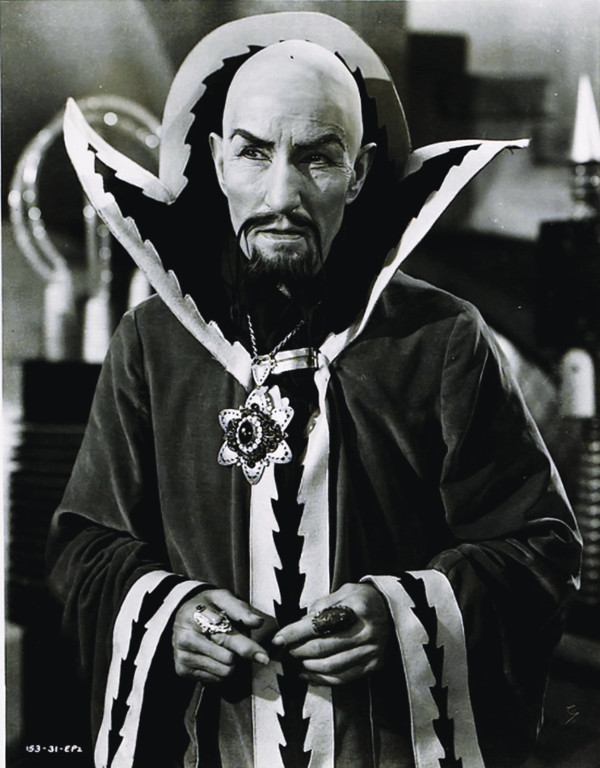
Most of Flash Gordon’s encounters with aliens is on the planet Mongo which is ruled by the sinister Emperor Ming. Flash battles with familiar animals, supported by the attachment of some outer space bling, or small animals filmed against miniature sets to make them appear gigantic, like the dragon-sized finned iguanas that prowl the valley where Flash and his entourage first land. The exception is the terrifying papier-mâché dragon with lobster claws that inhabits the Tunnel of Terror in chapter two; with the addition of horns and a wall of flame, it doubles as the Sacred Fire Dragon in chapter nine. The costumes of Ming’s empire are a mix of Space Age tunics, medieval robes, and Roman centurion armor for the men, and harem outfits for the women. The costumes (and most of the set dressing) are straight from Universal’s warehouses, but the mixture of styles isn’t that far off from Raymond’s comic strip design, which also borrowed freely from distant times and places from Earth’s history. The space classic Buck Rogers began its iconic space reign a few years later in 1939.
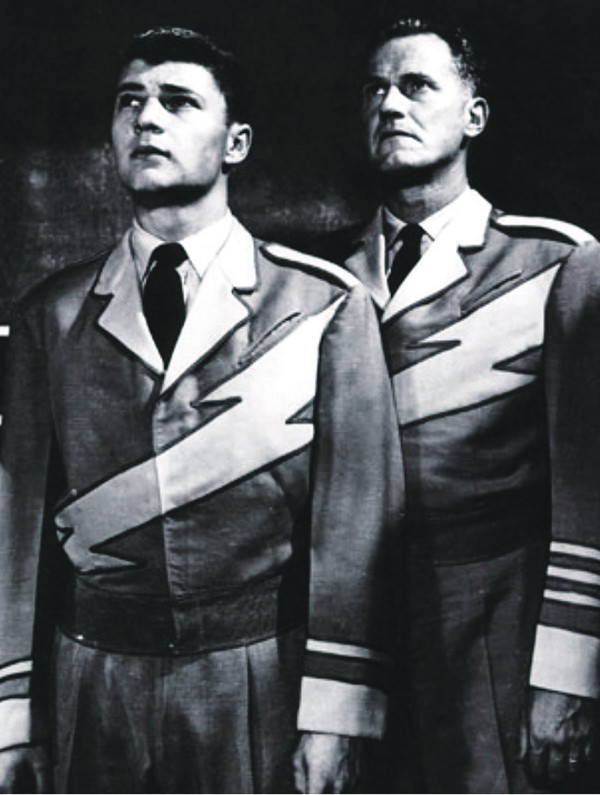
Captain Video and His Video Rangers (1949-55)
Captain Video was the first American science fiction television series. Set in the 21st century, Captain Video had a base on a mountain top with a young assistant called the Video Ranger. The series was extremely popular with children and adults but not so much with the critics. The plots often involved wildly implausible inventions made from cheap props. However, some of the scripts were written by a few major science fiction writers of the time.
The uniforms for Captain Video and his sidekick were U.S. Army surplus with lightning bolts sewn on the front. Captain Video’s nemesis, Dr. Pauli wore a gangster style pinstripe suit costume. Other scenes depict cowboy costumes as well as the tunics similar to Roman style dress! One of the more interesting costumes is the giant robot Tobor (robot spelled backwards) who comes under the control of a young girl who is determined to use the subservient machine against the Video Rangers. Interestingly enough, the Captain Video series is mentioned on the first episode of The Honeymooners TV series.
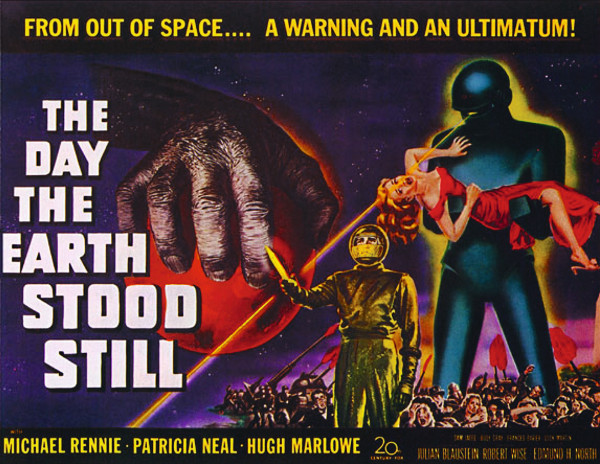
The Day the Earth Stood Still (1951)
In the movie, The Day the Earth Stood Still, an alien named Klaatu with his mighty robot Gort land their spacecraft on Cold War-era Earth. Klaatu is on a mission of peace. Gort appears to be constructed from a single piece of bendable metal. During the movie, actor Lock Martin, who played the robot, was in a silver-colored thick foam rubber suit that was designed and built by the film’s art director Addison Hehr. Two Gort suits were created, shown alternately from the front or back so that the robot could appear seamless depending on the camera angle. The supposedly solid metal suit did crease when Lock Martin walked; this was impossible to overcome at the time.
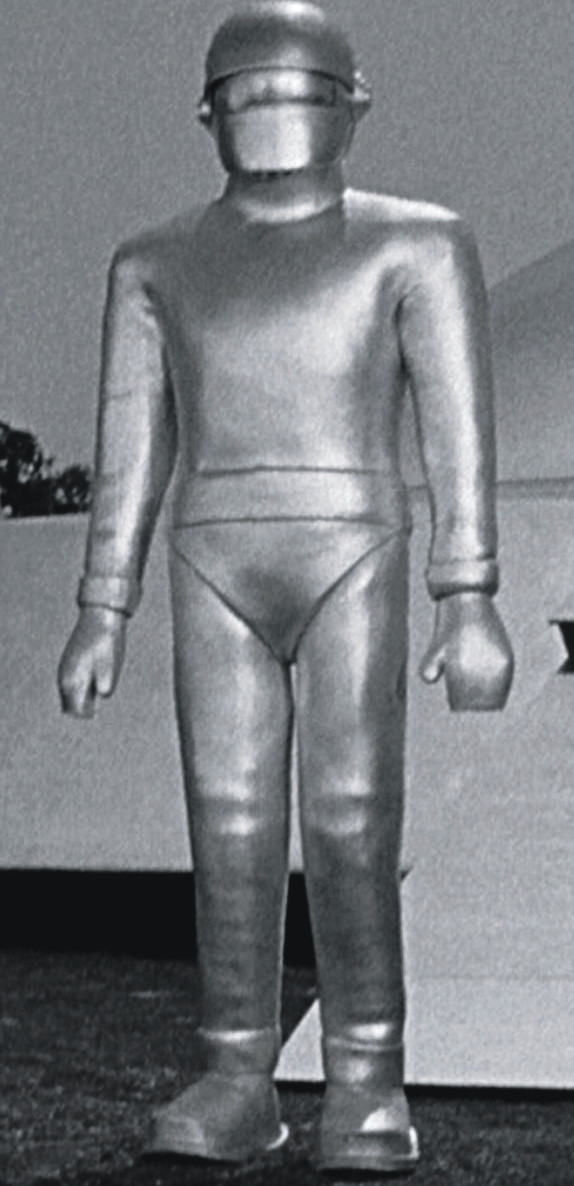
A fiberglass Gort was used for close-ups such as when he fired his laser beam weapon or when the scene did not call for him to move. Klaatu eventually tells the best scientists of the world that the aliens have watched them for centuries and humans have posed no potential harm until now. In a threatening address, he tells our species that we need to stop nuclear testing immediately if we want to have a future.
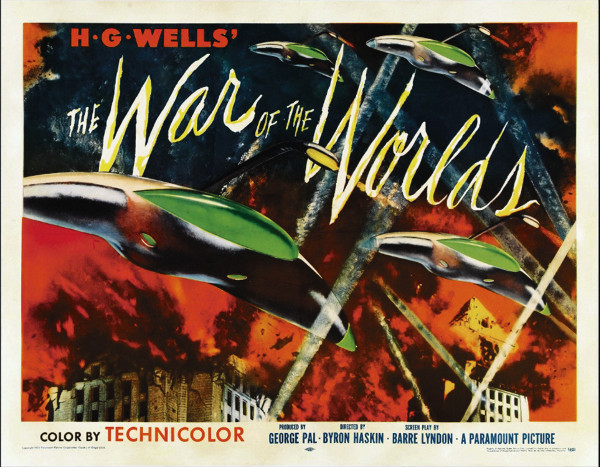
The War of the Worlds (1953)
From the brilliant mind of H.G. Wells came this vision of Earth under aerial alien siege. This time the aliens decided to wipe out our planet instead. Los Angeles is hit hard from Martian saucers and once they landed, the aliens were really grotesque looking. The special effects budget for this film was about $1.5 million. In the 1950s, this was a lot of money! In fact, The War of the Worlds actually won the 1953 Oscar for special effects. The movie wisely avoids showing us too much of the Martians themselves; the creature costumes are not nearly as good as the model war machines or the optical effects associated with them.
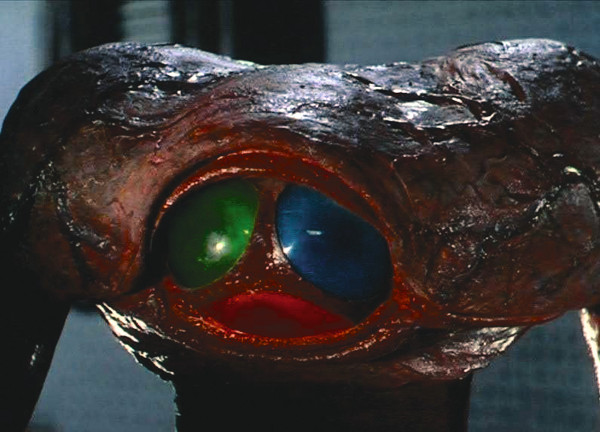
The film’s art director, Albert Nozaki, who designed the Martian, is seen briefly during the tense scene in which a cylinder crashes next to an abandoned farmhouse where Doctor Forrester and Sylvia have sought refuge. The elaborate alien prop was outfitted with an enormous three color eye, long arms with suction cup fingers, and pulsating veins throughout. The unforgettable alien suit was built and worn by Charles Gemora, who was a veteran of the Paramount makeup department since 1932. He was best known in Hollywood for his many film roles in a gorilla suit. The Martian was a rush job made from chicken wire, latex rubber, and tubing. It barely held together during the shoot.
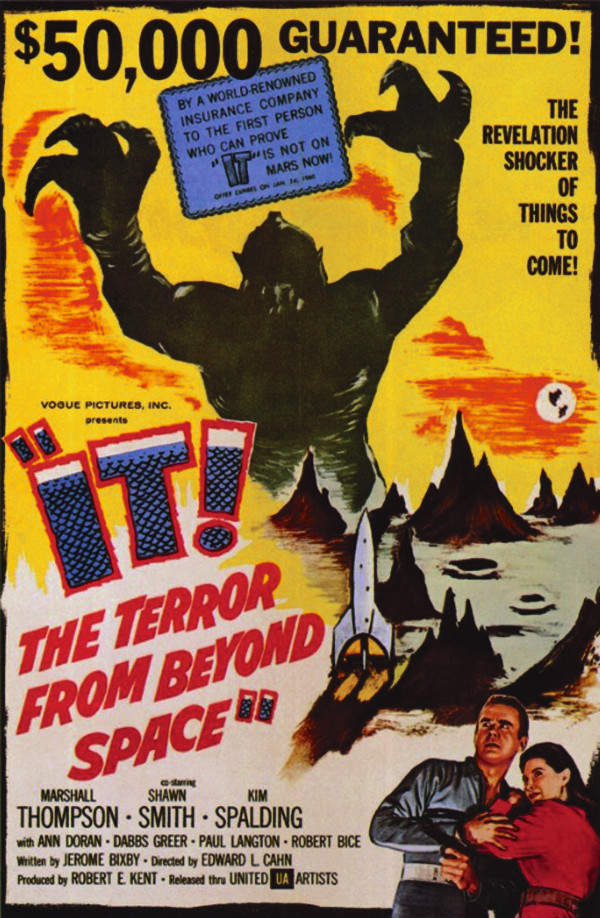
It! The Terror from Beyond Space (1958)
In 1973, the first manned expedition to Mars is decimated by an unknown life form which stows away on the rescue ship before it comes back to Earth. Ray Corrigan played the monster, but he wouldn’t travel to get measured for the suit, so makeup and special effects artist Paul Blaisdell had to sculpt the head over his own plaster bust. When Paul completed the outfit, the body of the creature was OK because Corrigan had sent over a pair of his long underwear, which Paul built the suit over.

When the mask was placed on Corrigan’s head, his bulbous chin stuck out through the monster’s mouth, so the makeup man improvised and painted his chin to look like a tongue instead. Paul also ended up cutting the eyes out but then the head of the production department demanded the monster have eyes. Paul built the eyes but they weren’t able to move. When the producers saw the eyes, they thought they were the worst eyes they had ever seen. So, Blaisdell decided to take latex and fill them in with rubber. This suit was funny too because Corrigan couldn’t see too well and had to actually lift the mask to readjust the eye holes during filming.
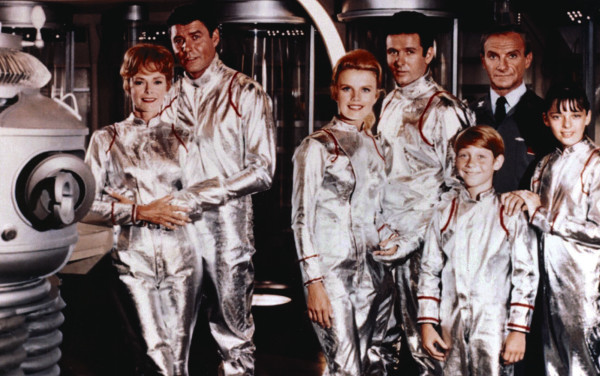
Lost in Space (1965-68)
In the year 1997, Earth is suffering from massive overpopulation. Doctor John Robinson, his wife Maureen, their children Judy, Penny, and Will, and Major Don West are selected to go to the third planet in the Alpha Centauri star system to establish a colony. The ship becomes hopelessly lost and it now becomes a fight for survival as the crew tries to find their way back home.
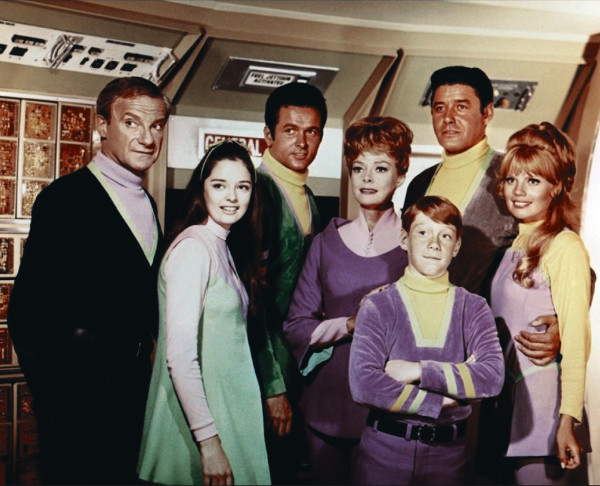
The costumes used on this TV series were made by Western Costume Co., according to the designs of the series art director Paul Zastupnevich. The silver space suits used in the first season were actually modified racing drivers’ fireproof aluminum suits. These suits were extremely hot and uncomfortable for the cast, who in between shots would drop down the tops so they could at least keep cool from the waist up. In the third season, the cast wore spacesuits made from a new fabric called Metlon-with-Mylar, which was an aluminum fiber coated with Mylar. This new fabric was more flexible and was not as hot. For the regular costumes used in all three seasons, Zastupnevich chose velour for the tunics. The pants were generally made of a stretch fabric called Elastique which allowed the actors room for stunts.
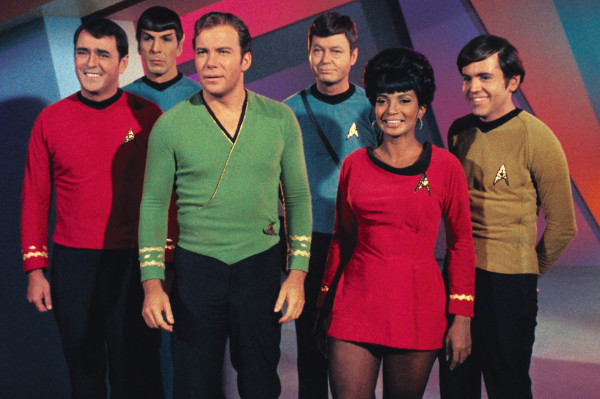
Star Trek (1966-69)
This TV series featured the adventures of the USS Enterprise, representing the United Federation of Planets on a five year mission in outer space to explore new worlds, seek new life and new civilizations, and to “boldly go where no man has gone before.”
Bill Theiss was the costume designer on the original Star Trek and for the first years of Star Trek: The Next Generation. He was responsible for the iconic Starfleet uniform designs that are so often copied these days. Although the standard command division uniform tunics looked gold on most color TV sets, the costumes were actually lime green. The greenish hue of the command tunics can be seen more clearly in the third season, when the fabric used for the tunics was changed from satin velour to a double knit fabric that reflected the set lighting better. The dress uniforms, made of a silk material, were always clearly green by comparison and some darker green jumpsuits and wraparound tunics that were more clearly seen, seemed to confirm that all the gold to green variations were part of the same color scheme. The so-called beige uniforms which originated with “The Cage,” were ironically a much more yellow color but likewise appeared beige or pinkish under the lights.
Fred Beauregard Phillips was the makeup artist for the original Star Trek TV series. He mentioned that Spock’s ears had to be molded daily in order to look right for the camera. These appliances were made of an expensive form of latex and they tore easily when being removed at the end of the day. Blessed with an unlimited budget and abundance of materials, he designed the original Klingons, Romulans, and all the other early Star Trek aliens.
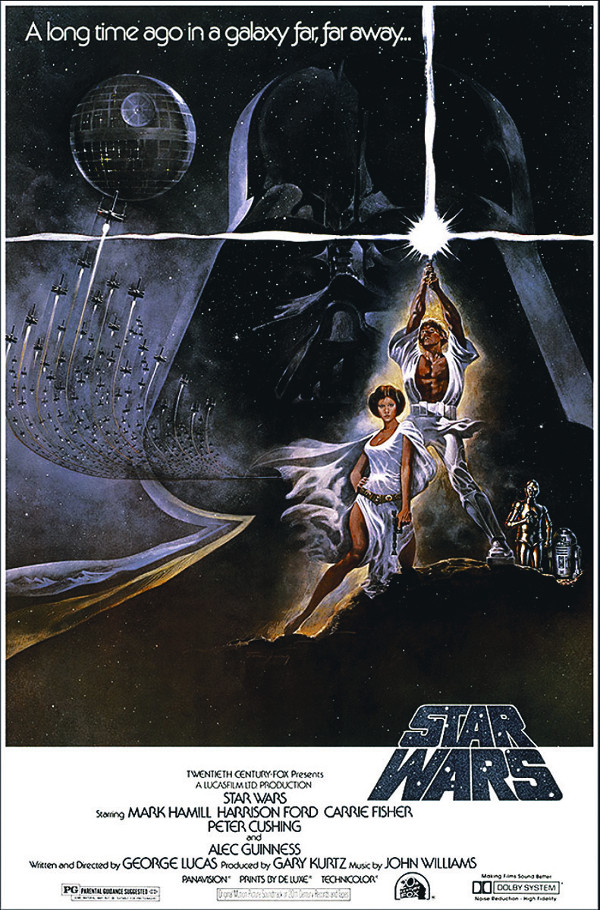
Star Wars (1977)
The blockbuster movie Star Wars took the world by storm in 1977 and became a pop culture phenomenon. Luke Skywalker joins forces with a Jedi Knight, a confident pilot, a Wookiee, and two droids to save the universe from the Empire’s world-destroying battle station, while also attempting to rescue Princess Leia from the evil and ruthless Darth Vader.
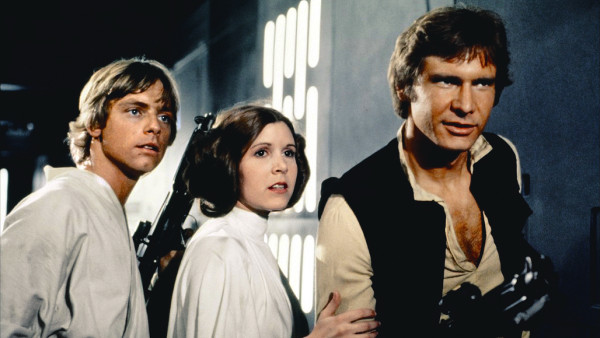
From the mind of creator George Lucas, to the concept artists who put those ideas to paper, to the artisans and costume designers who produced the fantastical, iconic wardrobes, Star Wars was a complex undertaking and it proved the importance of top-notch costume-making. John Mollo’s path to becoming a double Academy Award winning costume designer (Star Wars, and then Gandhi in 1983) was born out of a devoted love of European and American military uniforms. He was a master at developing designs that looked like real clothes instead of costumes.

Lucas hired legendary makeup supervisor Stuart Freeborn, recruited because of his work on the apes in the Dawn of Man sequence in Stanley Kubrick’s classic, 2001: A Space Odyssey. He assembled the Chewbacca costume with a combination of real yak and rabbit hair knitted into a base of mohair. The biggest problem during production, was when the actor’s body heat in the latex mask caused his face to detach from the costume’s eyes, making them look separate from the mask. Freeborn was also responsible for creating Jabba the Hutt, the insightful Yoda, also the Mos Eisley Cantina alien bar scene.
